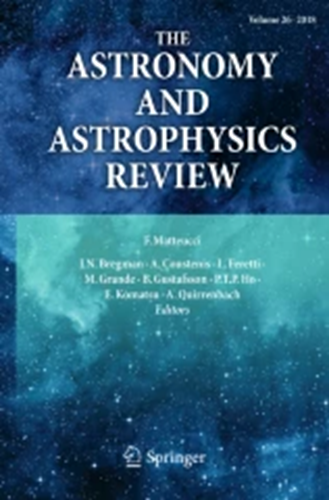异步双星的诱导微分旋转和混合
IF 26.5
1区 物理与天体物理
Q1 ASTRONOMY & ASTROPHYSICS
引用次数: 0
摘要
旋转有助于大质量恒星的内部混合过程和观测到的变化。相当数量的双星不是严格的同步旋转,包括所有的偏心系统。这导致了潮汐诱导的时变微分旋转结构。提出了一种探索异步旋转二元体旋转结构的方法。在重力、离心力、科里奥利力、气体压力和粘性力作用下,求解刚性旋转核心上方的三维体元网格的运动方程,得到角速度作为三个空间坐标和时间的函数。我们发现,诱导旋转结构及其时间变异取决于偏离同步性的程度。在偏心系统中,结构在轨道周期中发生变化,最大振幅可能发生在轨道相位,而不是在星周通道。我们讨论了时间相关的潮汐流在提高混合效率方面的可能作用,并推测,在这种情况下,缓慢旋转的异步双星可能比类似的更快旋转但潮汐锁定的系统具有更有效的混合。我们发现,一些观测到的氮丰度取决于轨道倾角,如果轨道倾角是真实的,则意味着恒星表面的化学分布不均匀,或者潮汐引起的光谱线变化(在赤道附近最强)影响丰度的测定。我们的模型预测,在忽略其他角动量传递机制的情况下,一个明显的初始微分旋转结构在粘性时间尺度上收敛于平均均匀旋转。我们建议,通过考虑异步旋转触发的过程,可以从更广泛的角度了解双星的结构、演化和变异性。本文章由计算机程序翻译,如有差异,请以英文原文为准。
Induced differential rotation and mixing in asynchronous binary stars
Rotation contributes to internal mixing processes and observed variability in massive stars. A significant number of binary stars are not in strict synchronous rotation, including all eccentric systems. This leads to a tidally induced and time-variable differential rotation structure. We present a method for exploring the rotation structure of asynchronously rotating binaries. We solve the equations of motion of a 3D grid of volume elements located above the rigidly rotating core in the presence of gravitational, centrifugal, Coriolis, gas pressure and viscous forces to obtain the angular velocity as a function of the three spatial coordinates and time. We find that the induced rotation structure and its temporal variability depend on the degree of departure from synchronicity. In eccentric systems, the structure changes over the orbital cycle with maximum amplitudes occurring potentially at orbital phases other than periastron passage. We discuss the possible role of the time-dependent tidal flows in enhancing the mixing efficiency and speculate that, in this context, slowly rotating asynchronous binaries could have more efficient mixing than the analogous more rapidly rotating but tidally locked systems. We find that some observed nitrogen abundances depend on the orbital inclination, which, if real, would imply an inhomogeneous chemical distribution over the stellar surface or that tidally induced spectral line variability, which is strongest near the equator, affects the abundance determinations. Our models predict that, neglecting other angular momentum transfer mechanisms, a pronounced initial differential rotation structure converges toward average uniform rotation on the viscous timescale. We suggest that by taking into account the processes that are triggered by asynchronous rotation, a broader perspective of binary star structure, evolution and variability may be gleaned.
求助全文
通过发布文献求助,成功后即可免费获取论文全文。
去求助
来源期刊

The Astronomy and Astrophysics Review
地学天文-天文与天体物理
CiteScore
45.00
自引率
0.80%
发文量
7
期刊介绍:
The Astronomy and Astrophysics Review is a journal that covers all areas of astronomy and astrophysics. It includes subjects related to other fields such as laboratory or particle physics, cosmic ray physics, studies in the solar system, astrobiology, instrumentation, and computational and statistical methods with specific astronomical applications. The frequency of review articles depends on the level of activity in different areas. The journal focuses on publishing review articles that are scientifically rigorous and easily comprehensible. These articles serve as a valuable resource for scientists, students, researchers, and lecturers who want to explore new or unfamiliar fields. The journal is abstracted and indexed in various databases including the Astrophysics Data System (ADS), BFI List, CNKI, CNPIEC, Current Contents/Physical, Chemical and Earth Sciences, Dimensions, EBSCO Academic Search, EI Compendex, Japanese Science and Technology, and more.
 求助内容:
求助内容: 应助结果提醒方式:
应助结果提醒方式:


